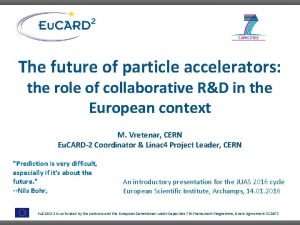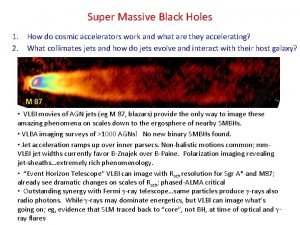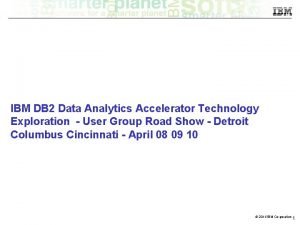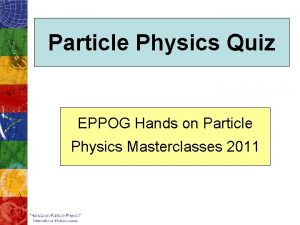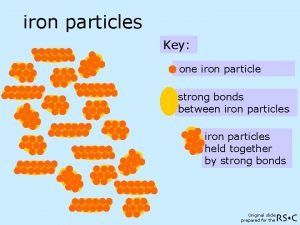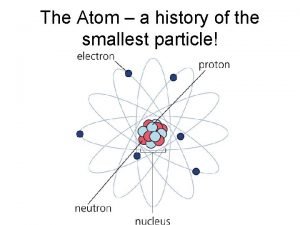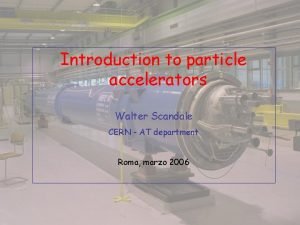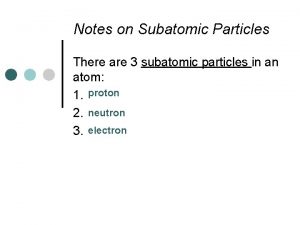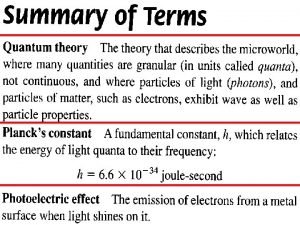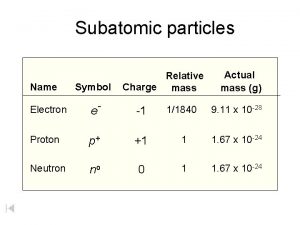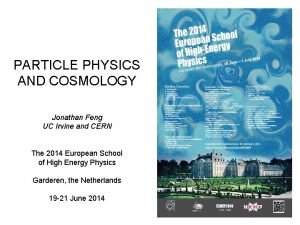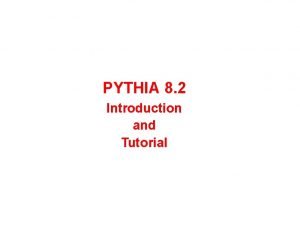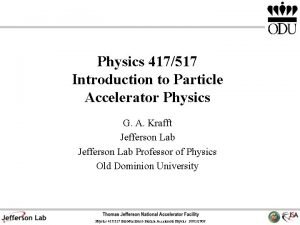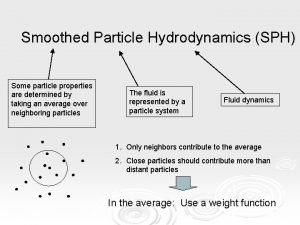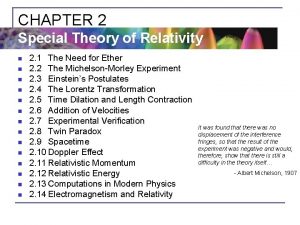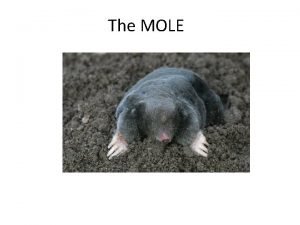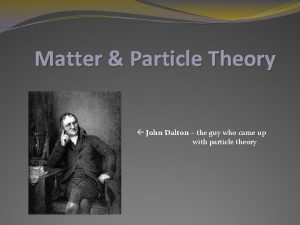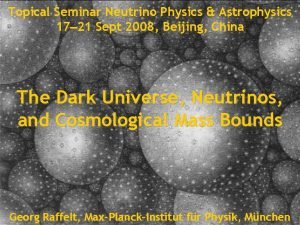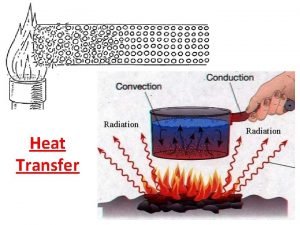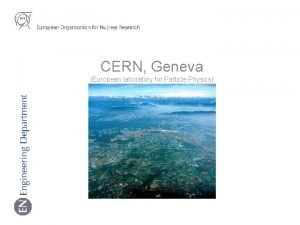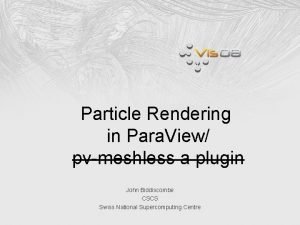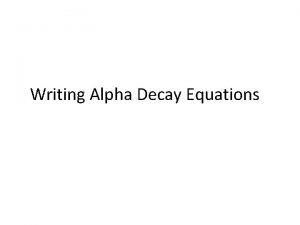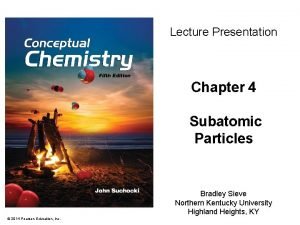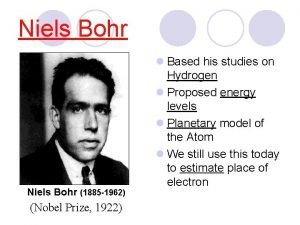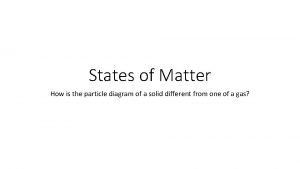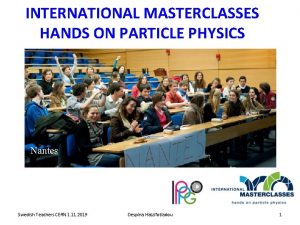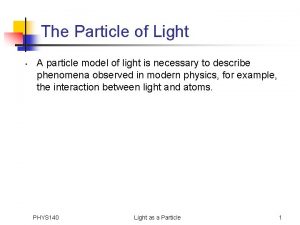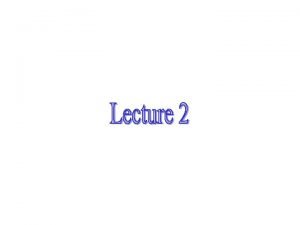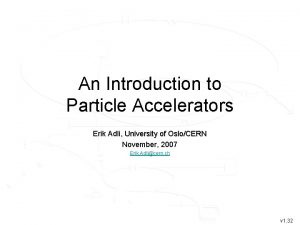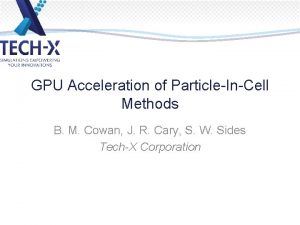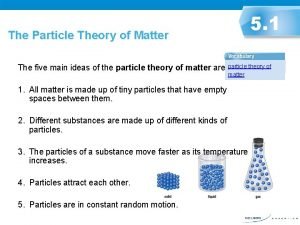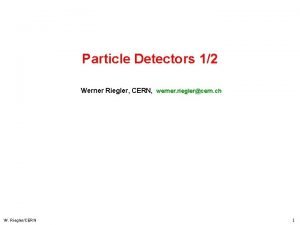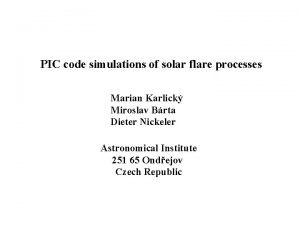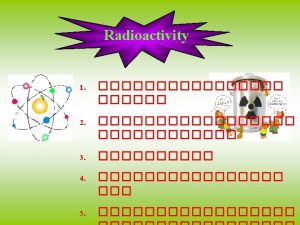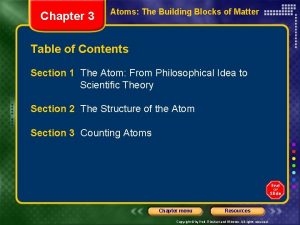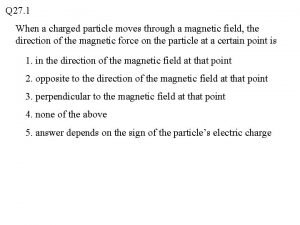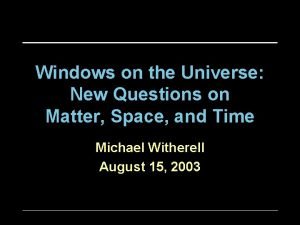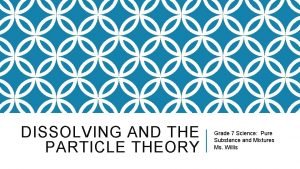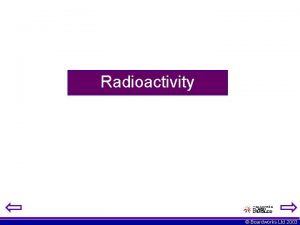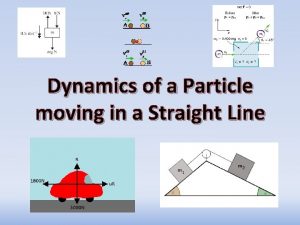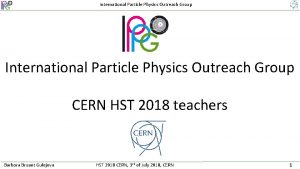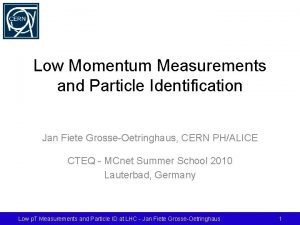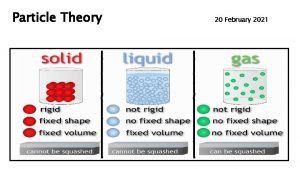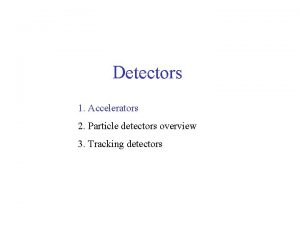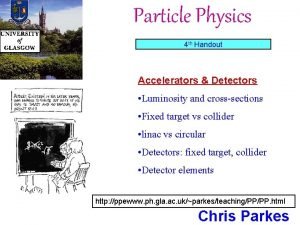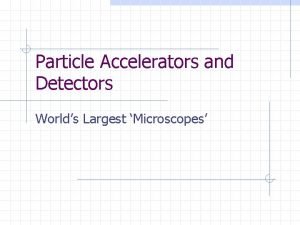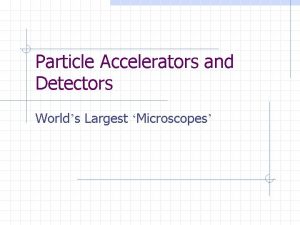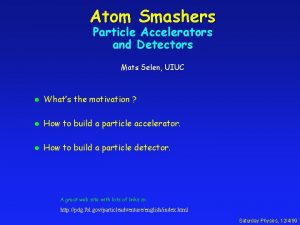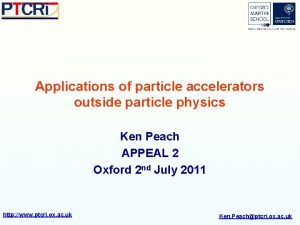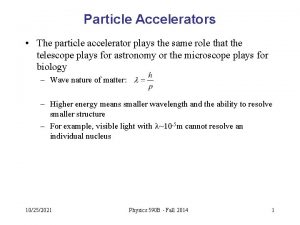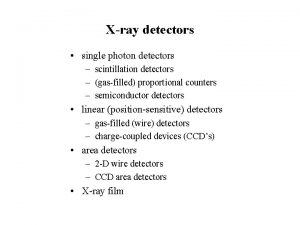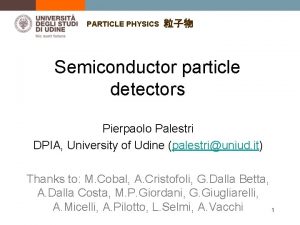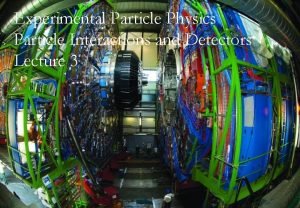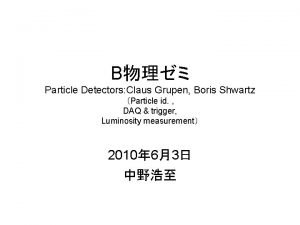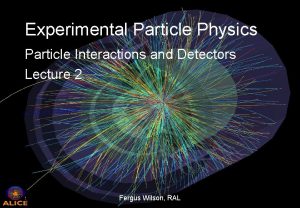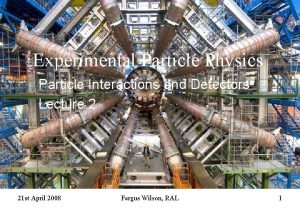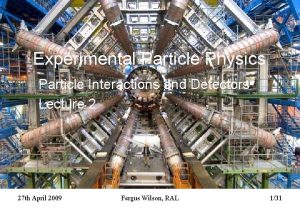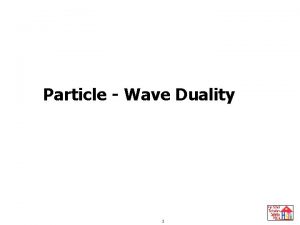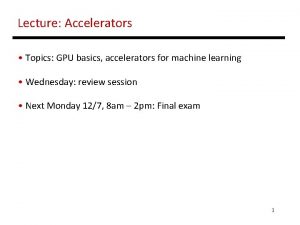Detectors 1 Accelerators 2 Particle detectors overview 3














































































- Slides: 78

Detectors 1. Accelerators 2. Particle detectors overview 3. Tracking detectors

Why do we accelerate particles ? Ø (1) To take existing objects apart Ø 1803 J. Dalton’s indivisible atom Øatoms of one element can combine with atoms of other element to make compounds, e. g. water is made of oxygen and hydrogen (OH) Ø 1896 M. & P. Curie find atoms decay Ø 1897 J. J. Thomson discovers electron Ø 1906 E. Rutherford: gold foil experiment Ø Physicists break particles by shooting other particles on them

Why do we accelerate particles ? Ø (2) To create new particles Ø 1905 A. Einstein: energy is matter E=mc 2 Ø 1930 P. Dirac: math problem predicts antimatter Ø 1930 C. Anderson: discovers positron Ø 1935 H. Yukawa: nuclear forces (forces between protons and neutrons in nuclei) require pion Ø 1936 C. Anderson: discovers pion muon Ø First experiments used cosmic rays that are accelerated for us by the Universe Øare still of interest as a source of extremely energetic particles not available in laboratories

Generating particles Ø Before accelerating particles, one has to create them Øelectrons: cathode ray tube (think your TV) Øprotons: cathode ray tube filled with hydrogen Ø It’s more complicated for other particles (e. g. antiprotons), but the main principle remains the same

Basic accelerator physics Ø Lorentz Force: F = q. E + q(v B) Ømagnetic force: perpendicular to velocity, no acceleration (changes direction) Øelectric force: acceleration

Accelerators: Cockroft-Walton Ø A (series of) voltage gap(s) Ø Maximum energy of a single gap is 200 k. V, limited by discharge Ø CW accelerator at Fermilab: 750 k. V

Accelerators: Van de Graaf Ø Van de Graaf generator: an electrostatic machine which uses a moving belt to accumulate very high voltages on a hollow metal globe 1: metallic sphere 2: electrode connected to 1 3: upper roller 4: belt (positive side) 5: belt (negative side) 6: lower roller 7: lower electrode (ground) 8: spherical device, used to discharge the main sphere 9: spark

Surfing the electromagnetic wave Ø Charged particles ride the EM wave Øcreate standing wave Øuse a radio frequency cavity Ømake particles arrive on time Ø Self-regulating: Øslow particle larger push Øfast particle small push

Surfing the electromagnetic wave

How to create a standing wave ? Ø Klystron (S. & R. Varian) Øelectrons flow into cavity, excite eigen modes Øcreates standing electromagnetic waves Ø A similar device (magnetron) found in your microwave oven 325 MHz Klystron for Proton Driver Linac (Fermilab)

Cyclotron Ø 1929 E. O. Lawrence ØThe physics: centripetal force mv 2/r = Bqv ØParticles follow a spiral in a constant magnetic field ØA high frequency alternating voltage applied between Delectrodes causes acceleration as particles cross the gap ØAdvantages: compact design (compared to linear accelerators), continuous stream of particles ØLimitations: synchronization lost as particle velocity approaches the speed of light the world largest cyclotron at TRIUMF (520 Me. V protons)

Synchrotron Ø The idea: both magnetic field strength and electric field frequency are synchronized with the traveling particle beam Øparticle trajectories confined to a thin vacuum beamline no large magnets, expandable Øsynchrotron radiation limits use for electrons Ø Currently, accelerators of this type provide highest particle energies in the world

Summary on accelerator types Ø Electrostatic accelerators Øacceleration tube: breakdown at 200 ke. V ØCockroft-Walton: improves to 800 ke. V Ø AC driven accelerators Ølinear: cavity design and length critical Øcircular accelerators: Øcyclotron: big magnet, non-relativistic Øsynchrotron: vacuum beamline, expandable, small magnets and cavities Øsynchrotron radiation large for light particles

Hadron vs electron colliders electron proton Point-like particle yes no Uses full beam energy yes no Transverse energy sum zero Longitudinal energy sum zero non-zero Synchrotron radiation large small

Large Electron-Positron collider Ø Location: CERN (Geneva, Switzerland) Øaccelerated particles: electrons and positrons Øbeam energy: 45 104 Ge. V, beam current: 8 m. A Øthe ring radius: 4. 5 km Øyears of operation: 1989 2000

Tevatron Ø Location: Fermilab (Batavia, IL) Øaccelerated particles: protons and anti-protons Øbeam energy: 1 Te. V, beam current: 1 m. A Øthe ring radius: 1 km Øin operation since 1983

Large Hadron Collider Ø Location: CERN (Geneva, Switzerland) Øaccelerated particles: protons Øbeam energy: 7 Te. V, beam current: 0. 5 A Øthe ring radius: 4. 5 km Øscheduled start: 2007

Future of accelerators Ø International Linear Collider: 0. 5 3 Te. V Øawaiting directions from LHC findings Øpolitical decision of location Ø Very Large Hadron Collider (magnet development ? ): 40 200 Te. V Ø Muon Collider (source ? ) 0. 5 4 Te. V Ølepton collider without synchrotron radiation Øcapable of producing many more Higgs particles compared to an e+e collider

Conclusions Ø Motivation for particle acceleration Øunderstand matter around us Øcreate new particles Ø Particle accelerator types Øelectrostatic: limited energy ØAC driven: linear or circular Ø Modern accelerators ØTe. Vatron, LHC Øaccelerators to come: ILC, VLHC, muon collider…

Detectors 1. Accelerators 2. Particle detectors overview 3. Tracking detectors

Detectors and particle physics Ø detectors allow one to detect particles Øexperimentalists study their behavior Ønew particles are found by direct observation or by analyzing their decay products Øtheorists predict behavior of (new) particles Øexperimentalists design the particle detectors

Overview of particle detectors Ø What do particle detectors measure ? Øspatial location Øtrajectory in an EM field momentum Ødistance between production and decay point lifetime Øenergy Ømomentum + energy mass Øflight times Ømomentum/energy + flight time mass

Natural particle detectors Ø A very common particle detector: the eye Ødetected particles: photons Øsensitivity: high (single photons) Øspatial resolution: decent Ødynamic range: excellent (1 1014) Øenergy range: limited (visible light) Øenergy discrimination: good Øspeed: modest (~10 Hz, including processing)

Photographic paper Ø 1895 W. C. Röntgen: sensitivity to high energy photons (X-rays) invisible to the eye Øworking medium: emulsion Ø Properties: Ødetected particles: photons Øsensitivity: good Øspatial resolution: very good Ødynamic range: good Øno online recording Øno speed resolution

The Geiger counter Ø 1908 H. Geiger Øpassing charge particles ionize the gas Øions (electrons) drift towards cathode (anode) Øcause an electric pulse, can be heard in a speaker Ø Properties: Ødetected particles: charged particles (electrons, , …) Øsensitivity: single particles Øspatial resolution: none (detector size) – can be fixed Ødynamic range: none – can be fixed Øspeed: high (determined by charge drift velocity)

The cloud chamber Ø 1911 C. T. R. Wilson (1927 Nobel Prize) Øthe first tracking detector (tracking=many spatial measurements per particle) Ø Principle of operation: Øan air volume is saturated with water vapor Øpressure lowered to generate super-saturated air Øcharge particles cause saturation of vapor into small droplets can be observed as a “track” Øphotographs allow longer inspection

The cloud chamber Ø Properties: Ødetected particles: charged particles (electrons, , …) Øsensitivity: single particles Øspatial resolution: excellent Ødynamic range: good Øas particle slows down, droplets occur closer to each other Øif placed inside a magnet, can observe curled trajectories Øspeed: limited (need time to recover the super-saturated state)

Photographic emulsions Ø Rarely used in modern experiments due to principal restrictions: Øcannot be read out electronically Øused to need a lot of technicians looking at photographs by eye – inefficient, boring, and error prone Øtoday using pattern recognition software (think OCR) Øcannot be used online Ø One advantage is excellent spatial resolution (<1 m) Ø Were used in the -neutrino discovery (DONUT, 2000)

Modern detector types Ø Tracking detectors Ø detect charged particles Ø principle of operation: ionization Ø two basic types: gas and solid Ø Scintillators Ø sensitive to single particles Ø very fast, useful for online applications Ø Calorimeters Ø measure particle energy Ø usually measure energy of a bunch of particles (“jet”) Ø modest spatial resolution Ø Particle identification systems Ø recognize electrons, charged pions, charged kaons, protons

Tracking detectors Ø A charged track ionizes the gas Ø 10— 40 primary ion-electron paris Ø multiplication 3— 4 due to secondary ionization Ø typical amplifier noise 1000 e— Ø the initial signal is too weak to be effectively detected ! Ø as electrons travel towards cathode, their velocity increases Ø electrons cause an avalanche of ionization (exponential increase) Ø The same principle (ionization + avalanche) works for solid state tracking detectors Ø dense medium large ionization Ø more compact put closer to the interaction point Ø very good spatial resolution

Calorimetry Ø The idea: measure energy by total absorption Øalso measure location Øthe method is destructive: particle is stopped Ødetector response proportional to particle energy Ø As particles traverse material, they interact producing a bunch of secondary particles (“shower”) Øthe shower particles undergo ionization (same principle as for tracking detectors) Ø It works for all particles: charged and neutral

Electromagnetic calorimeters Ø Electromagnetic showers occur due to ØBremsstrahlung: similar to synchrotron radiation, particles deflected by atomic EM fields Øpair production: in the presence of atomic field, a photon can produce an electron-positron pair Øexcitation of electrons in atoms Ø Typical materials for EM calorimeters: large charge atoms, organic materials Øimportant parameter: radiation length

Hadronic calorimeters Ø In addition to EM showers, hadrons (pions, protons, kaons) produce hadronic showers due to strong interaction with nuclei Ø Typical materials: dense, large atomic weight (uranium, lead) Øimportant parameter: nuclear interaction length Ø In hadron shower, also creating non detectable particles (neutrinos, soft photons) Ølarge fluctuation and limited energy resolution

Muon detection Ø Muons are charged particles, so using tracking detectors to detect them ØCalorimetry does not work – muons only leave small energy in the calorimeter (said to be “minimum ionization particles”) ØMuons are detected outside calorimeters and additional shielding, where all other particles (except neutrinos) have already been stopped ØAs this is far away from the interaction point, use gas detectors

Detection of neutrinos Ø In dedicated neutrino experiments, rely on their interaction with material Øinteraction probability extremely low need huge volumes of working medium Ø In accelerator experiments, detecting neutrinos is impractical – rely on momentum conservation Øelectron colliders: all three momentum components are conserved Øhadron colliders: the initial momentum component along the (anti)proton beam direction is unknown

Multipurpose detectors Ø Today people usually combine several types of various detectors in a single apparatus Ø goal: provide measurement of a variety of particle characteristics (energy, momentum, flight time) for a variety of particle types (electrons, photons, pions, protons) in (almost) all possible directions Ø also include “triggering system” (fast recognition of interesting events) and “data acquisition” (collection and recording of selected measurements) Ø Confusingly enough, these setups are also called detectors (and groups of individual detecting elements of the same type are called “detector subsystems”)

Generic HEP detector

D detector at Fermilab Ø D detector is one of two large multipurpose detectors at Fermilab (another one is CDF) Øname = one of six intersection points

D : fairly typical HEP detector

D : tracking system (1) Ø Vertex detector: Silicon Microstrip Tracker Øfour layers of silicon detectors intercepted with twelve disks + (recent addition) Layer 0

D : tracking system (2) Ø Outer tracking detector: Central Fiber Tracker Øsixteen double layers of scintillating fibers

D : calorimeter Ø Liquid argon / uranium calorimeter, consisting of central and two end calorimeters

D : outer muon system Ø The outermost part of the detector, surrounds the whole thing ØProportional Drift Tubes, Mini Drift Tubes ØCentral (Forward) muon SCintillators

D : other elements Ø Magnet: a central solenoid magnet (2 T) and outer toroid magnet Ø Luminosity scintillating counters Ø Central and forward preshower Ø Forward proton detector (Roman pots) Ø Data acquisition, trigger system, …

Conclusions Ø Particle detectors follow simple principles Ødetectors interact with particles Ømost interactions are electromagnetic Øimperfect by definition but have gotten pretty good Øcrucial to figure out which detector goes where Ø Three main ideas Øtrack charged particles and then stop them Østop neutral particles Øfinally find the muons which are left

Detectors 1. Accelerators 2. Particle detectors overview 3. Tracking detectors

Gas detectors Ø As a charged particle crosses a gas volume, it creates ionization Øelectrons get kicked out of atoms Øthe rest of atom becomes electrically charged (ion) Ø In absence of external field, ions and electrons recombine back to neutral atoms Øelectrons drift to anode Øions drift to cathode E = V/r ln(b/a)

Ionization Ø Affected by many factors Øgas temperature Øgas pressure Øelectric field Øgas composition Ø Important parameters: Øionization potential Ømean free path Ø Some gases eat up electrons (“quenchers”)

Ionization as a function of energy Ø Ionization probability gas dependant Ø General features: Øthreshold (~20 e. V) Øfast turn on Ømaximum (~100 e. V) Øsoft decline e. V

Mean free path Ø Average distance an electron travels before it hits an atom – determined by gas density Ø At ambient pressure (1013 h. Pa), air density is 2. 7 1019 molecules/ccm, and mean free path is 68 m Ø At high vacuum (10— 3… 10— 7 h. Pa), mean free path is 0. 1… 1000 m

What happens after ionization ? Ø After collision, ions (electrons) thermalize and travel until neutralized through electron (ion), wall, negative ion (other molecule) Ø Mean free path for electrons ~4 times longer than for ions Ø Ions diffuse slowly, electrons diffuse quickly Ø Diffusion velocity depends on gas

Avalanche Ø Steps of an avalanche: Ø a primary electron proceeds towards the anode, experiencing ionizing collisions Ø due to the lateral diffusion, a drop-like avalanche, surrounding the wire, develops Ø electrons are collected during ~1 ns Ø a cloud of positive ions slowly migrates towards the cathode

Ionization chamber Ø Low voltage, no secondary ionization – just collect ions Øexample: smoke detector Øradiation source (Am-241) emits -particles Øthey pass through ionization chamber, creating current Øsmoke absorbs -particles and interrupts current

Proportional counter Ø Higher voltage, tuned to provide proportional regime: Øeach avalanche is created independently from others total amount of charge created remains proportional to the amount of charge liberated in the original event, which in turn is proportional to the particle’s kinetic energy

Spark chamber Ø Device similar to Geiger counter Ø Ionizing particles produce sparks along its way that can be photographed and used later for reconstruction of tracks ØMy diploma work was done on the ITEP’s 3 m magnet spectrometer equipped with spark chambers

Regimes in a tracking chamber

Gas tracking detectors: summary detector voltage avalanches regime ionization chamber low no single ion collection proportional counter medium isolated proportional Geiger-Müller counter high maximal saturated

Multi Wire Proportional Chamber Ø 1968 G. Charpak (1992 Noble Prize) Øthe idea: make a proportional counter with a lot of anodes placed between two cathode planes Øby looking at which wires were fired, can determine position of the particle Øif the proportional mode is used, can determine particle’s energy + improve position resolution (by interpolation) Ødrift chambers: measure time of arrival of the electron avalanche improve position resolution + provide a timing reference point

MWPC electric field Ø Homogeneous field away from anode wires Ø Field near wires very sensitive to their position from G. Charpak’s Noble lecture

MWPC design Ø Constraints Øprecise position measurements require precise and small wire spacing Øhomogeneous fields require small wire spacing Ølarge fields require thin wires Øgeometric tolerances cause gain variations Ø Geometry and problems Ørequired precision: sub millimeter Ølong chambers need strong wires (W/Au plated) and high tension to minimize sagging

Choice of gas Ø It’s a magic Ølow working voltage Øhigh gain operation Øgood proportionality Øhigh rate capability Ølong lifetime Øfast recovery Øprice Ø…

Operation conditions Ø Pressure: slightly above atmospheric Øavoid incoming gas “pollution” Øa large tracker is not really air tight Ønot too high (difficult to maintain) Ø Temperature: slightly lower than room t. Øavoid large temperature gradients Øaffected by environment (e. g. cooling of nearby systems)

Limitations of chambers Ø High occupancy: OK Øused in Alice (heavy ion collisions at LHC) Ø Radiation hardness Øtough but manageable (need gas flow) Ø Speed Øis a problem for LHC applications (25 ns bunch crossing) Øion drift is limiting factor Øcan be addressed with special technologies (GEM)

Time Projection Chamber (RHIC) Ø Brookhaven Nat’l Lab, Relativistic Heavy Ion Collider Ø Shown: Gold-Gold collision

Solid state detectors Ø Basic operation principle same as gas detectors gas liquid solid Density low moderate high Atomic number low moderate Ionization energy moderate low Signal speed moderate high

Silicon detectors Ø Solid state tracking detectors: semiconductor diodes with reverse bias Ønormally there is no current (except very low “dark current”) Øa charged particle creates a track of carriers (electronhole pairs) along its way charge pulse

Why silicon ? Ø Low band gap width: 1. 12 e. V (large number of charge carriers / unit energy loss) Ø Energy to create an e/h pair: 3. 6 e. V (an order of magnitude smaller than ionization energy for gases) Øhigh carrier yield Ølow Poisson noise Øno gain stage required Øbetter energy resolution and high signal

Why silicon ? (cont’d) Ø High density and atomic number Øreduced range of secondary particles Øcan build thin detectors Øbetter spatial resolution Ø High carrier mobility Øtypical charge collection times <30 ns Øno slow component (ions) Ø Excellent mechanical rigidity Ø Industrial fabrication techniques Ø Detector and electronics can be integrated

Problems Ø Cost Øproportional to area covered Ømost of the cost is moving to read out channels Ø Material budget Øfor complex detectors can be as large as ~1— 2 radiation lengths Øaffects calorimeters behind the detector Øaffects tracking accuracy (multiple scattering) Ø Typically need cooling to reduce leakage current (thermal energy = 1/40 e. V)

Radiation hardness Ø What is it ? Øparticles damage silicon crystal structure Øband gap decreases Øleakage currents increase Øgain drops Ødetector looses efficiency and precision Ø What to do ? Øexchange detectors ØATLAS: replace inner detector after 3 yrs of operation Øswitch to radiation hard technology (e. g. diamonds)

Diode strip detectors Ø Idea (1980’s): divide the large-area diode into many small strip-like regions and read them out separately ØTypical strip pitch p = 20—few hundred m ØPosition measurement precision: Ødigital readout: = p/ 12 Øanalog readout: = p/(S/N) (S = signal, N = noise)

-function Ø Let a particle pass the detector between two strips (i) and (i+1) at coordinate x = xi…xi+p Ø If strip (i) collects charge qi, and strip (i+1) collects charge qi+1, (x) = qi/(qi+qi+1) Øideally, (x) = 1, x<xi+p/2, and (x) = 0, x>xi+p/2 Øin practice, it’s not true: Øfinite charge cloud size (~5 m) Øcharge capacitance between strips Ønon-uniform electric field

Lorentz shift Ø If a detector is placed in magnetic field (parallel to its strips), charge careers are deflected as they drift towards the strips Øintroduces systematic shift of the measured position Øsignal gets spread between several strips Øincreases cluster sharing (bad) Øwith analog readout, improves spatial resolution (good)

Double sided readout detectors Ø Idea: use both types of carriers to make two position measurements for the same amount of material n-side charge ØUsually cross strips 2 -dim measurement ØFrom charge correlation can resolve ambiguities p-side charge

Pixel detectors Ø Provide 3 -dim points with very high precision Ømain issue is readout Øcan read out individual pixels or entire rows/columns Ø Electrodes are close ! Ølow full bias Ølow collection distance Øno charge spreading Øfast charge sweep out

Pixel vs strip detector operation Si. O 2 +ve -ve -ve p+ h+ h+ e- n E W 3 D pixel detector E e- n+ +ve strip detector W 2 D

Pixel detector at ATLAS

Conclusions Ø Tracking detectors Ødetect charged particles Ømeasure arrival time and charge deposition Øderive 3 dimensional location and energy Ø Design Øinner detectors: silicon (strip/pixel), highest track density resolution (tens of m) Øouter detectors: gas detectors, lower resolution (hundreds of m)
 The long-term future of particle accelerators
The long-term future of particle accelerators Good to great technology accelerators
Good to great technology accelerators Good to great presentation
Good to great presentation Accelerators computer architecture
Accelerators computer architecture Cosmic super accelerators
Cosmic super accelerators Slidetodoc
Slidetodoc Analytics query accelerators
Analytics query accelerators Feature detectors
Feature detectors Vhv voltage detectors
Vhv voltage detectors Streaming current detectors
Streaming current detectors Where are feature detectors located
Where are feature detectors located Giant wave detectors murmurs universe
Giant wave detectors murmurs universe Frontier detectors for frontier physics
Frontier detectors for frontier physics Photo detectors
Photo detectors Feature detectors ap psychology
Feature detectors ap psychology Giant gravitational wave detectors hear murmurs
Giant gravitational wave detectors hear murmurs Yodsawalai chodpathumwan
Yodsawalai chodpathumwan Nuclear detectors
Nuclear detectors Rhmd: evasion-resilient hardware malware detectors
Rhmd: evasion-resilient hardware malware detectors What is thermal detector
What is thermal detector Which detector used in hplc
Which detector used in hplc Particle therapy masterclass
Particle therapy masterclass Formula units to moles
Formula units to moles Particle physics practice quiz
Particle physics practice quiz Subatomic particles of iron
Subatomic particles of iron Magnetic force particle
Magnetic force particle Equilibrium of a particle
Equilibrium of a particle Energy of particle in a box
Energy of particle in a box Underline the correct phrase in each sentence
Underline the correct phrase in each sentence Particle model of matter exam questions
Particle model of matter exam questions Youtube https //www.youtube.com/watch v=vnp84pn0mjq
Youtube https //www.youtube.com/watch v=vnp84pn0mjq Smallest known particle
Smallest known particle Field particle
Field particle Subatomic particles table
Subatomic particles table Light behaves primarily as a particle when it
Light behaves primarily as a particle when it Proton symbol relative charge and location
Proton symbol relative charge and location Form factor particle physics
Form factor particle physics Symbol for beta particle
Symbol for beta particle Gamma rays who discovered
Gamma rays who discovered Wet etch clean and filter
Wet etch clean and filter Pythia8 tutorial
Pythia8 tutorial Physics
Physics Smoothed particle hydrodynamics
Smoothed particle hydrodynamics Relativistic velocity
Relativistic velocity Si base unit
Si base unit What is matter
What is matter ;,dk jhd'v
;,dk jhd'v A small, solid particle that travels through space.
A small, solid particle that travels through space. Radiation
Radiation European laboratory for particle physics
European laboratory for particle physics God particle plugin
God particle plugin What does an alpha particle look like
What does an alpha particle look like The first subatomic particle discovered was the
The first subatomic particle discovered was the Louis de broglie wave particle duality
Louis de broglie wave particle duality Equilibrium definition
Equilibrium definition Particle diagram of a solid
Particle diagram of a solid International masterclasses hands on particle physics
International masterclasses hands on particle physics The particle model of light
The particle model of light Mass of beta particle
Mass of beta particle Proton
Proton Particle in cell
Particle in cell Particle theory of matter
Particle theory of matter Werner riegler cern
Werner riegler cern Particle atom molecule
Particle atom molecule Chromoshere
Chromoshere Freezing particle theory
Freezing particle theory Whats a beta particle
Whats a beta particle Chapter 3 atoms the building blocks of matter
Chapter 3 atoms the building blocks of matter When a charged particle moves in a region of magnetic field
When a charged particle moves in a region of magnetic field Particle physics
Particle physics Particle model dissolving
Particle model dissolving Alpha particle production
Alpha particle production Solid element particle diagram
Solid element particle diagram Odderon
Odderon Dynamics of a particle moving in a straight line
Dynamics of a particle moving in a straight line Cern particle physics
Cern particle physics Particle identification
Particle identification Www.youtube.com
Www.youtube.com Primeradiant
Primeradiant
